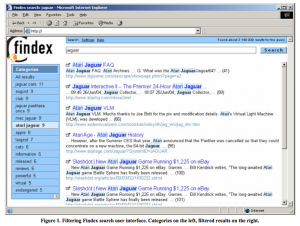Käki, M. (2005). Findex: search result categories help users when document ranking fails. Proceedings of the SIGCHI conference on Human factors in computing systems, CHI ’05 (pp. 131–140). New York, NY, USA: ACM. doi:10.1145/1054972.1054991
In this study, a web search tool enhanced with categories was used by 16 users over a 2 month period – a longitudinal, naturalistic study.
It was found that when the search rankings did not deliver a good result at the top of the list, categories enabled users to find results that appear deeper down in the list of results.
Categories were created based on word frequencies in the result summaries. The set of collections is on the left, the main results on the right as seen in the screenshot below.
Query length in the study averaged 2 terms, consistent with previous studies.
Categories were used in over 25% of the searches, in these searches an average of 2.3 categories were used.
Main findings:
- ”categories are used in real settings and that users find relevant results with them” – users found categories interface helpful when evaluating the result set
- “categories are beneficial when result rankings fail” – when results are not found in the top results of the ranked list, categories help users find a useful result. This is particularly useful when the query is vague or broad. 45% of users reported using less precise queries than in a non-enhanced interface
- “categories can forgive mistakes in searching” – when the categories were used, there are fewer cases where no results were found. This is useful less precise queries are used, as is common in unfamiliar domains
- “categories make it easier to access multiple results” – their use increases the cases where more than one result was selected.





